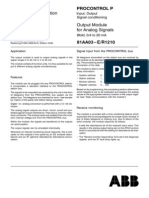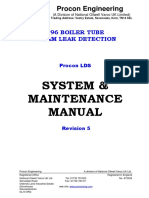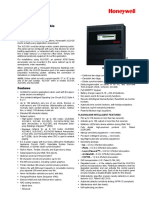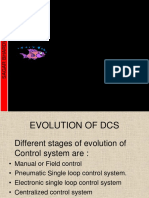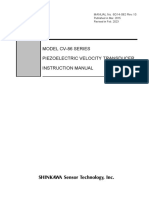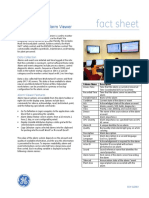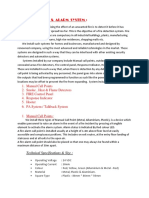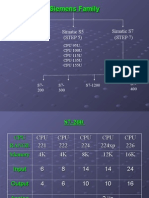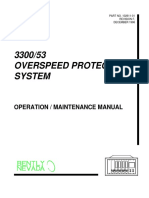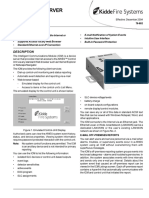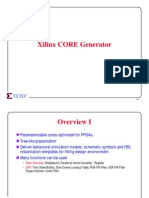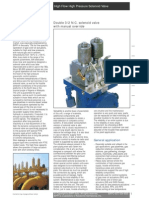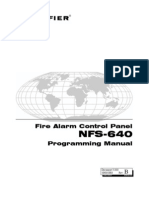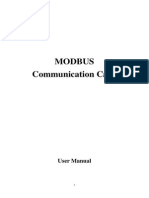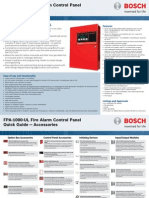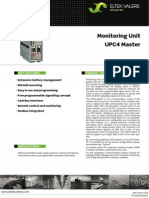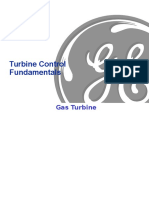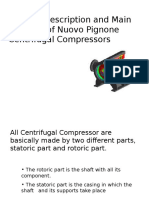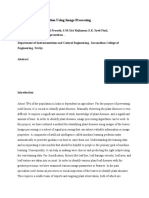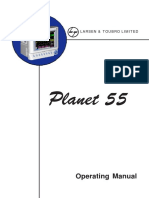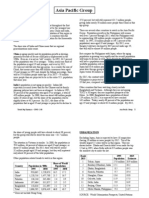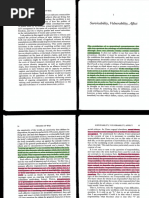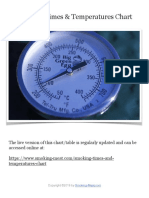Exfire360 Fire&Gas Control Panel
Exfire360 Fire&Gas Control Panel
Uploaded by
KorichiKarimCopyright:
Available Formats
Exfire360 Fire&Gas Control Panel
Exfire360 Fire&Gas Control Panel
Uploaded by
KorichiKarimOriginal Description:
Copyright
Available Formats
Share this document
Did you find this document useful?
Is this content inappropriate?
Copyright:
Available Formats
Exfire360 Fire&Gas Control Panel
Exfire360 Fire&Gas Control Panel
Uploaded by
KorichiKarimCopyright:
Available Formats
EUSEBI IMPIANTI srl
Via Mario Natalucci, 6
60131 ANCONA ITALY
Tel. +39.071.9504900
FIRE AND GAS
Technical data sheet
Codice
Code
eusebi@eusebi-impianti.it
Fg.
Sh.
Di
Of
EXFIRE360 FIRE&GAS CONTROL PANEL
EXFIRE360 FIRE&GAS CONTROL PANEL
The EXFIRE360 control system is a dual-CPU, programmable and versatile control panel developed to perform
integrated functions related to fire alarm management and fire suppression actuation. EXFIRE360 can be
manufactured according to the safety requirements and is easily configurable using Protection software.
EXFIRE360 panels can be networked via TCP/IP, RS-485, RS-232 and fiber optics, making it possible to design a
network system with remote chassis. All communications are redundant, while Enterprise software (if required)
provides central or supervising station capabilities. The panel is modular, consisting of 19-inch racks with I/O cards
for fire detection and/or suppression and/or building automation. The cards are located inside the panel, while the
displays (with RS-485 redundant communication) are installed at the front.
In case of failure, cards can be replaced quickly without having to operate on the terminals. In fact, terminals of the
cards are accessible from the rear side of the panel. EXFIRE360 offers a series of cards (with hot swapping
capability) for monitoring analogue addressable detectors, conventional lines, analogue/digital inputs and outputs
and for the control of fire suppression systems. All card displays are touch-screen with command keys for various
functions, such as viewing events or perform advanced diagnostics on inputs and outputs.
EXFIRE3
60
fire&gas
control
panel
(views
from
outside
and
inside)
EUSEBI IMPIANTI srl
Via Mario Natalucci, 6
60131 ANCONA ITALY
Tel. +39.071.9504900
FIRE AND GAS
Technical data sheet
Codice
Code
eusebi@eusebi-impianti.it
EXFIRE360 FIRE&GAS CONTROL PANEL
System certifications and approvals
EN 54-2:1997+A1:2006
Fire detection and fire alarm systems - Part 2: control and indicating equipment
In addition to the mandatory requirements, the following optional functions are certified:
-
output to fire alarm devices;
output to fire alarm routing equipment;
output to fire protection equipment;
delays to outputs;
dependency on more than one fire alarm signal (type C);
alarm counter;
fault signal from initiating/notification devices;
output to fault warning routing equipment;
disabled condition of addressable devices;
test condition;
normalized input/output interface.
EN 54-4:1997+A1:2002+A2:2006
Fire detection and fire alarm systems - Part 4: power supply equipment)
EN 12094-1:2003
Fixed firefighting systems - Components for gas extinguishing systems Part 1: requirements and test methods for electrical automatic control
and delay devices (only for EX6EV-C card)
Available (certified) options with requirements:
-
delay on extinguishing signal;
signal representing the flow of extinguishing agent;
monitoring of the status of components;
emergency hold device;
manual only mode;
triggering of equipment within the system;
triggering of equipment outside the system;
extinguishing signal to reserve cylinders;
discharge inhibition.
IEC 61508
Functional safety of electrical/electronic/programmable electronic safety-related systems
The following configurations were considered:
- safety function 1: automatic fire suppression with analog input trigger;
- safety function 2: analog redundant gas detection and gas valve shutoff;
- safety function 3: automatic fire suppression with input trigger from analogue addressable
devices.
Hochiki ESP compatibility
Fg.
Sh.
Di
Of
EUSEBI IMPIANTI srl
Via Mario Natalucci, 6
60131 ANCONA ITALY
Tel. +39.071.9504900
FIRE AND GAS
Technical data sheet
Codice
Code
eusebi@eusebi-impianti.it
Fg.
Sh.
Di
Of
EXFIRE360 FIRE&GAS CONTROL PANEL
Mechanical description
Standard EXFIRE360 fire&gas control panel is composed and assembled on a self standing IP54 cabinet, RAL7035,
with front access and predetermined size 2100 (h) x 800 (W) x 1600 (D) mm. Cabinets with reduced dimensions are
also available, on the basis of the actual composition of the panel.
The panel consists of the following components:
a main base rack with a touch-screen display (with integrated keyboard) and two CPUs;
additional racks for I/O modules (installed on the rear side of the panel);
a series of chassis for housing the card displays;
a power supply unit (two front-end 40 A units);
battery controller for monitoring primary and secondary power supplies;
battery package designed to meet the requirements of secondary power supply.
Set of input and output modules
Up to six subracks for the I/O modules can be installed in the EXFIRE360 panel. Each subrack is designed for a
maximum of ten modules; the maximum number of modules for a single panel is therefore equal to sixty.
Following is the list of modules available to perform fire detection, fire alarm and suppression functions:
EX8SI
module with eight supervised inputs
EX2GSI
module with two 4-20 mA analogue input lines
EX8RO
module with eight SPDT relay outputs
EXLOOP-E
analogue addressable module for Hochiki ESP devices
EX6SO
module with six supervised 24 V outputs
EX8D I/O
module with eight digital inputs and outputs
EX6EV
module for the activation of solenoid valves (to be combined with EX8SI for fire suppression
purposes)
MULTIBUS
module for the communication with third-party systems
EX6EV-C
EN 12094-1 certified fire extinguishing control module (combines EX6EV and EX8SI).
Provides ten supervised inputs, four supervised outputs, two SPDT relays and fourteen
open collector outputs.
Every I/O module is equipped with seven open collector outputs (except for EX8RO).
EXFIRE360s I/O modules
EUSEBI IMPIANTI srl
Via Mario Natalucci, 6
60131 ANCONA ITALY
Tel. +39.071.9504900
FIRE AND GAS
Technical data sheet
Codice
Code
eusebi@eusebi-impianti.it
Fg.
Sh.
Di
Of
EXFIRE360 FIRE&GAS CONTROL PANEL
Main technical specifications
Primary power supply: 230 Vac, 50/60 Hz
24Vdc power: power supply unit certified according to EN 544 standard
Battery controller: EN 544 certified
Maximum current required: 10 A @230 Vac
Maximum output current: 40A (redundant if required), to be supplied to the panel and the load.
Maximum charging current (to standby batteries): 40 A
Rated output voltage: 27,7 Vdc
Output voltage interval: 23 29 Vdc
Minimum voltage without primary power: 20 Vdc
Maximum battery capacity: 2x12 V, 700Ah
Output float voltage: 30mV (0.1%, measured)
Operating temperature: from 5 to +40C
Maximum number of CPUs: 2
Maximum number of I/O modules per cabinet: 60 I/O modules
Maximum number of fire suppression modules: 29 EX6EVC modules
CPU redundancy: yes
Hot replacement of I/O modules: yes
Communication protocols available: TCP-IP, CANbus, RS485, 1019E, Modbus.
Graphical monitoring software: SV Enterprise, graphical user interface for standalone or networked panels.
Communication interfaces: n.1 RS232, n.1 100 Mbps Ethernet with RJ45 connector o F.O. connector
available with additional EXMULTIBUS module.
Default outputs: available on primary EX6SO module.
Modules for initiating device circuits: EX8SI, EX2GSI, EXLOOPE (for analogue fire detectors),
Can Bus protocol
EXFIRE360 system is based on CAN bus protocol for the communication between the I/O modules and the main
processing unit. This introduces a series of advantages over the proprietary protocols, which can be summarized as
follows:
fixed response time, which represents a critical requirement in process control and fire safety applications:
CAN technology offers a full range of hardware and software tools whereby a big number of devices can be
connected to the network while respecting rigorous response time intervals.
Ease and flexibility: CAN bus is a serial link based on a twisted pair (either shielded or not). Network nodes
do not have an identification address, therefore nodes can be added or removed without having to rearrange
the system.
High immunity to disturbances: ISO 11898 standard requires that processors dedicated to CAN bus
communication shall work even under extreme circumstances, such a single-open or ground fault of a
conductor.
Proven reliability: error detection and retransmission of data is hardware-controlled with five different
methods (two at the bit level and three related to the messages).
Error confinement: each node is capable of detecting any abnormal condition and self-disabling. This
mechanisms permits to comply with the stringent time-response requirements, thus avoiding that any node
impairs the operation of the entire system.
Broadcast Communication: each of the devices on the network has a CAN controller chip and is therefore
intelligent. All devices on the network see all transmitted messages. Each device can decide if a message is
relevant or if it should be filtered. This structure allows modifications to CAN networks with minimal impact.
Additional non-transmitting nodes can be added without modification to the network.
Priority: every message has a priority, so if two nodes try to send messages simultaneously, the one with the
higher priority gets transmitted and the one with the lower priority gets postponed. This arbitration is nondestructive and results in non-interrupted transmission of the highest priority message. This also allows
networks to meet deterministic timing constraints.
EUSEBI IMPIANTI srl
Via Mario Natalucci, 6
60131 ANCONA ITALY
Tel. +39.071.9504900
FIRE AND GAS
Technical data sheet
Codice
Code
eusebi@eusebi-impianti.it
Fg.
Sh.
Di
Of
EXFIRE360 FIRE&GAS CONTROL PANEL
Experience: the broad diffusion of CAN bus protocol over the last twenty years has lead to the development
of several microprocessors, transceivers, development tools, with a significant cost reduction. CAN bus is
currently considered a standard protocol in the industry.
CPU redundancy:
EXFIRE360 system is provided with dual redundant CPUs. CPUs are equipped with a static un-buffered RAM for the
storage of operating data of the panel, while the configuration settings are stored in a NAND flash memory. This
solution increases significantly the reliability of the CPUs.
Operators interface:
EXFIRE360 introduces a new concept of diagnostics of inputs and outputs. Each
module has a touch-screen display with real-time information of the status of each
channel, card diagnostics and temperature and humidity of the card. These data
simplify the interaction between the operator and the panel in case of alarm,
trouble and during functional testing and maintenance.
Touch-screen displays of
I/O modules
EUSEBI IMPIANTI srl
Via Mario Natalucci, 6
60131 ANCONA ITALY
Tel. +39.071.9504900
FIRE AND GAS
Technical data sheet
Codice
Code
Fg.
Sh.
Di
Of
eusebi@eusebi-impianti.it
EXFIRE360 FIRE&GAS CONTROL PANEL
Architecture of the fire alarm system: key concepts
Designing a fire alarm system with EXFIRE360 control panel provides the following key advantages:
1. the system is fully certified for fire detection, fire alarm and suppression according to EN mandatory
standards
2. the most critical fire protection functions are also certified for the functional safety (up to SIL 3 rating) by a
third-party agency. This ensures lower lifecycle costs, improves quality & reliability and reduces risk
(accidents) and liability.
3. The panel is modular, thus permitting to expand the system if required without having to install additional
panels.
4. All input/output modules are hot pluggable, thus minimizing downtime costs in case of failures. The operator
could directly replace faulty modules with spare ones. Modules are also automatically addressed by the
panel, which further simplifies any maintenance work.
5. Advanced diagnostics increases the information available to the operator, who has therefore the possibility to
supervise the status of each input and output as well as the operating parameters of each module with no
specific tools or instruments.
6. CAN bus protocol provides the ability to connect remote chassis or network the fire alarm control panels,
thus improving the flexibility of the system.
7. MULTIBUS module makes available a series of interfaces (Ethernet, RS485, CAN Bus) for transmitting
signals to third-party systems (e.g. DCS) or for connecting monitoring stations with Enterprise graphical
software.
A simplified architecture of the fire alarm system considered in this project is shown below.
BUILDING 1
MAIN DISPLAY
BUILDING 5
DCS or monitoring software
CAN bus
I/O CHASSIS
CAN bus
I/O CHASSIS
Local fire alarm
control panel #1
MAIN DISPLAY
CAN bus
Addressable smoke
detectors, heat detectors,
manual call points, etc
Notification appliances, fire
extinguishing systems,
interface with HVAC, etc.
CAN bus network over F.O.
I/O CHASSIS
I/Os
CAN bus
I/O CHASSIS
I/Os
Local fire alarm
control panel #4
BUILDING 4
CAN bus network over F.O.
REMOTE I/O
CHASSIS
BUILDING 2
I/Os
MAIN DISPLAY
BUILDING 3
CAN bus
I/O CHASSIS
CAN bus
I/O CHASSIS
Addressable smoke
detectors, heat detectors,
manual call points, etc
MAIN DISPLAY
Notification appliances, fire
extinguishing systems,
interface with HVAC, etc.
I/O CHASSIS
Local fire alarm
control panel #2
CAN bus
I/Os
CAN bus
I/O CHASSIS
CAN bus network over F.O.
Local fire alarm
control panel #3
I/Os
You might also like
- LM2500 Course PDFDocument86 pagesLM2500 Course PDFKorichiKarim100% (13)
- Gas Turbine Operation & Maintenance CourseDocument100 pagesGas Turbine Operation & Maintenance CourseMohammed El-Shahat89% (9)
- Digital Overspeed - Protection System: Short DescriptionDocument8 pagesDigital Overspeed - Protection System: Short DescriptionYohannes S Aripin100% (1)
- 81aa03 Er1210Document9 pages81aa03 Er1210Mahesh KumbharNo ratings yet
- Procon LDS Maintenance Manual-R5Document18 pagesProcon LDS Maintenance Manual-R5Watchara ThepjanNo ratings yet
- INIM Catalogo Incendio ENG Rev3.00 MediumRes PDFDocument76 pagesINIM Catalogo Incendio ENG Rev3.00 MediumRes PDFnedzadNo ratings yet
- Mark VIeDocument11 pagesMark VIebobyNo ratings yet
- XLS3000 SpecsheetDocument6 pagesXLS3000 SpecsheetWenceslao CabreraNo ratings yet
- 2.seguridad Intrinseca PDFDocument104 pages2.seguridad Intrinseca PDFerstendrainNo ratings yet
- ProximitySensorsCompared InductiveCapacitivePhotoelectricUltrasonicDocument60 pagesProximitySensorsCompared InductiveCapacitivePhotoelectricUltrasonicAriPermanaNo ratings yet
- Foxboro Eckardt Valve Pos e (HA031644 Issue 3)Document28 pagesFoxboro Eckardt Valve Pos e (HA031644 Issue 3)islamooov0% (1)
- Distributed Control SystemDocument42 pagesDistributed Control SystemAdventurer100% (1)
- Calibration Procedure For BFP-T Turbine Rotor Expansion SensorDocument9 pagesCalibration Procedure For BFP-T Turbine Rotor Expansion Sensornaresh977977No ratings yet
- DCS SystemDocument19 pagesDCS Systemubaid100% (2)
- Manual CV-861Document18 pagesManual CV-861aladin namlunNo ratings yet
- Generator ExcitationDocument4 pagesGenerator ExcitationKVV100% (1)
- Air Polution Control - Project (Rockwell)Document16 pagesAir Polution Control - Project (Rockwell)Chandan MandalNo ratings yet
- Basic Instrumentation and Process ControlDocument2 pagesBasic Instrumentation and Process ControlathariqubalNo ratings yet
- GEA-S1206 WorkstationST Alarm ViewerDocument2 pagesGEA-S1206 WorkstationST Alarm ViewerjosseNo ratings yet
- PLC Error CodesDocument43 pagesPLC Error CodesJuan Dela CruzNo ratings yet
- Senscient ELDS Instruction ManualDocument122 pagesSenscient ELDS Instruction ManualAlan García Perez100% (1)
- Flamonitec Bfi Products Catalog 2021-11 En-2Document28 pagesFlamonitec Bfi Products Catalog 2021-11 En-2Gennithony EsonNo ratings yet
- Woodward 505 Steam Turbine Control: Operator TrainingDocument25 pagesWoodward 505 Steam Turbine Control: Operator TrainingRobby RattleNo ratings yet
- Specifications and Ordering Information 3500-93 System DisplayDocument10 pagesSpecifications and Ordering Information 3500-93 System DisplayP KUBERUDUNo ratings yet
- Fire Detection & Alarm SystemDocument6 pagesFire Detection & Alarm SystemHarikrishnaNo ratings yet
- Process Control System PCS 7 Industry Library (V9.0)Document1,264 pagesProcess Control System PCS 7 Industry Library (V9.0)Rubio Hernández Jesús DavidNo ratings yet
- SiemensDocument23 pagesSiemensRahul Jain100% (1)
- Highway Addressable Remote Transducer (HART)Document41 pagesHighway Addressable Remote Transducer (HART)RajeshNo ratings yet
- COMBUSTION MONITORING - MS9001FA+eDocument18 pagesCOMBUSTION MONITORING - MS9001FA+eShivam Singh100% (1)
- Manual BacnetDocument52 pagesManual BacnetGustavo CortesNo ratings yet
- 3300XL 11mm PDFDocument22 pages3300XL 11mm PDFinelecstarNo ratings yet
- 3300 53 Overspeed Protection System Operations and Maintenance Manual 102611-01Document88 pages3300 53 Overspeed Protection System Operations and Maintenance Manual 102611-01NICONo ratings yet
- Masibus 85xxDocument2 pagesMasibus 85xxsterling tmlNo ratings yet
- Modulo de Accesso A Internet PDFDocument2 pagesModulo de Accesso A Internet PDFWilliam Segundo Matheus TorresNo ratings yet
- Xilinx CORE GeneratorDocument39 pagesXilinx CORE GeneratorSuhas Shirol100% (1)
- F 0077 e 55Document6 pagesF 0077 e 55Bùi Cảnh TrungNo ratings yet
- 6 ABB SACE Solutions For Protection Against Earth Fault: General AspectsDocument33 pages6 ABB SACE Solutions For Protection Against Earth Fault: General AspectsHoa Nguyen Van100% (1)
- Condition Monitoring of Electrical EquipmentsDocument67 pagesCondition Monitoring of Electrical EquipmentsPunkajGupta100% (2)
- Nor GrenDocument5 pagesNor GrenSarlo11No ratings yet
- Modbus TCP Client RTU Slave MN67010 ENGDocument9 pagesModbus TCP Client RTU Slave MN67010 ENGRoger HazimNo ratings yet
- Control of Emissions From Power PlantsLarge Scale IndustriesDocument48 pagesControl of Emissions From Power PlantsLarge Scale IndustriesSonu Kumar100% (2)
- Hybrid Fiber - Coaxial Networks: Technology and Challenges in Deploying Mul? - Gigabit Access ServicesDocument23 pagesHybrid Fiber - Coaxial Networks: Technology and Challenges in Deploying Mul? - Gigabit Access ServicesAnonymous dqs4mKRXCNo ratings yet
- Distributed Control SystemDocument31 pagesDistributed Control SystemAbdullah BarkaNo ratings yet
- 1 Technical Product Guide Trident v2 SystemsDocument58 pages1 Technical Product Guide Trident v2 Systemsmorales_francisco21No ratings yet
- KINAX 2W2 Data Sheet EnglishDocument8 pagesKINAX 2W2 Data Sheet Englishyoeckoe100% (1)
- What Is Distributed Control System?Document4 pagesWhat Is Distributed Control System?Narasimha PrabhuNo ratings yet
- MTL Hart Muxes PDFDocument30 pagesMTL Hart Muxes PDFmasimeriseNo ratings yet
- M Notifier Manual Programacion Nfs 640Document116 pagesM Notifier Manual Programacion Nfs 640Victor Manuel Nava HerreraNo ratings yet
- FCM and FRM Series: Control and Relay Modules With Flashscan®Document4 pagesFCM and FRM Series: Control and Relay Modules With Flashscan®terminatorNo ratings yet
- Foxboro Evo™ Process Automation System: Product SpecificationsDocument20 pagesFoxboro Evo™ Process Automation System: Product SpecificationsWijnandNo ratings yet
- DN 6871Document2 pagesDN 6871ErcarErcar100% (1)
- Creating and Using Virtual DPUsDocument20 pagesCreating and Using Virtual DPUsDeepak Gupta100% (1)
- Siemens 7819 Siemens Sinteso Mp1Document10 pagesSiemens 7819 Siemens Sinteso Mp1Arman Ul NasarNo ratings yet
- Monitoring of Generator Stator End - Winding Vibration How Reliable Are Existing Monitoring Systems?Document9 pagesMonitoring of Generator Stator End - Winding Vibration How Reliable Are Existing Monitoring Systems?Kevin Luis Perez Quiroz100% (1)
- Atex 3116Document30 pagesAtex 3116Alessandro MoroniNo ratings yet
- GenieATM ISPEdition UserManual v5.3.2 Eng (NetStream) PDFDocument338 pagesGenieATM ISPEdition UserManual v5.3.2 Eng (NetStream) PDFAbolfazl_Najafi100% (1)
- GPS DCS Time SyhchronisationDocument6 pagesGPS DCS Time Syhchronisationkoushik42000No ratings yet
- Modbus Card Manual PDFDocument16 pagesModbus Card Manual PDFElias Ulises Manriquez FuentealbaNo ratings yet
- S000e Pakscan Systems GlossyDocument16 pagesS000e Pakscan Systems Glossyhizbi7No ratings yet
- Quick Selection Guide 2690044555Document2 pagesQuick Selection Guide 2690044555Alejandro JoséNo ratings yet
- DS - UPC4 - Master Communication ModuleDocument2 pagesDS - UPC4 - Master Communication ModuleSriram SubramanianNo ratings yet
- Appendix: Writing A Doctoral DissertationDocument8 pagesAppendix: Writing A Doctoral DissertationKorichiKarimNo ratings yet
- Sonatrach Antisurge PDFDocument214 pagesSonatrach Antisurge PDFKorichiKarim100% (3)
- 3641-Ge Frame 9e Turbines PDFDocument5 pages3641-Ge Frame 9e Turbines PDFKorichiKarim100% (1)
- GEA32129A Heavy Duty Gas Turbine Monitoring Protection - R1 PDFDocument48 pagesGEA32129A Heavy Duty Gas Turbine Monitoring Protection - R1 PDFramkrishnaNo ratings yet
- Vadodara Institute of Engineering: Surging and ChokingDocument16 pagesVadodara Institute of Engineering: Surging and ChokingKorichiKarimNo ratings yet
- 505c PiecesDocument347 pages505c PiecesKorichiKarimNo ratings yet
- 02 Technical Report Corrosion and Mitigation in Fire Systems FM Research Jul 2014Document98 pages02 Technical Report Corrosion and Mitigation in Fire Systems FM Research Jul 2014KorichiKarim100% (1)
- Week 8: 2.16 - Lubricating Oil Specification 2.17 - Types of Lubricating Oil 2.9 & 2.10 - Types of Journal BearingDocument18 pagesWeek 8: 2.16 - Lubricating Oil Specification 2.17 - Types of Lubricating Oil 2.9 & 2.10 - Types of Journal BearingKorichiKarimNo ratings yet
- Control FundamentalDocument82 pagesControl FundamentalKorichiKarim100% (2)
- Centrifugal Compressor: Gas PathDocument49 pagesCentrifugal Compressor: Gas PathKorichiKarim100% (4)
- 05 CC Off Designe Operating OverviewDocument8 pages05 CC Off Designe Operating OverviewKorichiKarim100% (2)
- CC General DescriptionDocument40 pagesCC General DescriptionKorichiKarim100% (2)
- Compressor Surge and Operation Rev1Document28 pagesCompressor Surge and Operation Rev1KorichiKarim100% (2)
- Wheelspace 150212063314 Conversion Gate02Document15 pagesWheelspace 150212063314 Conversion Gate02KorichiKarim100% (1)
- Sonatrach Antisurge PDFDocument214 pagesSonatrach Antisurge PDFKorichiKarimNo ratings yet
- Gas Turbine 3Document45 pagesGas Turbine 3KorichiKarim100% (2)
- Bernoulli Equation: Z P P V G HLDocument2 pagesBernoulli Equation: Z P P V G HLKorichiKarimNo ratings yet
- Plant Start-Up - 1111Document5 pagesPlant Start-Up - 1111KorichiKarim100% (1)
- (Said S.E.H. Elnashaie, Parag Garhyan) ConservatioDocument661 pages(Said S.E.H. Elnashaie, Parag Garhyan) ConservatioFouratZarkounaNo ratings yet
- Researchonline@Jcu: Continuity of The Pajingo Epithermal Gold System. MastersDocument18 pagesResearchonline@Jcu: Continuity of The Pajingo Epithermal Gold System. MastersFrank AliagaNo ratings yet
- Plant Pathology Detection Using Image Processing Journal PaperDocument9 pagesPlant Pathology Detection Using Image Processing Journal PaperHARIPRASATH ECENo ratings yet
- Larsen & Toubro Planet 55 Monitor - User ManualDocument158 pagesLarsen & Toubro Planet 55 Monitor - User ManualMaria Chirinos RodriguezNo ratings yet
- Marking Scheme (( Class - Xii Maths)3 )Document5 pagesMarking Scheme (( Class - Xii Maths)3 )refrigerater0No ratings yet
- Jesus Is All The World To Me-ChordsDocument2 pagesJesus Is All The World To Me-Chordsfacebook natanielNo ratings yet
- IP Radio Soluiton New Feature 120322Document22 pagesIP Radio Soluiton New Feature 120322Jose VazNo ratings yet
- Northwest Mud Fest: RaymondDocument92 pagesNorthwest Mud Fest: RaymondkilljoymsfNo ratings yet
- Analysis RavishankarDocument196 pagesAnalysis RavishankarKavya sriNo ratings yet
- Lesson Plan Final 1Document10 pagesLesson Plan Final 1Panget pangetNo ratings yet
- On Computer Networking and SecurityDocument14 pagesOn Computer Networking and SecurityshitaltadasNo ratings yet
- AGP Population TrendsDocument36 pagesAGP Population TrendsPatrick AdamsNo ratings yet
- Lecture 9 EvaporationDocument23 pagesLecture 9 EvaporationrupokistiyakNo ratings yet
- Ese 570 Mos Inverters: Static CharacteristicsDocument42 pagesEse 570 Mos Inverters: Static CharacteristicsVipul MistryNo ratings yet
- Isolated Footing Design (Square Footing)Document5 pagesIsolated Footing Design (Square Footing)Santosh BasnetNo ratings yet
- SPR Time Table 22 23Document11 pagesSPR Time Table 22 23ananyaphotos.iitkgp21No ratings yet
- 1974 Spring - Nevada Outdoors and Wildlife ReviewDocument28 pages1974 Spring - Nevada Outdoors and Wildlife ReviewbrucedcarlsonNo ratings yet
- (Questionpaperz - In) UPSEE Previous Paper 2004Document38 pages(Questionpaperz - In) UPSEE Previous Paper 2004Pushpendra ShawNo ratings yet
- Service Manual Sigma Control 80 - XXDocument169 pagesService Manual Sigma Control 80 - XXvdalsheroqNo ratings yet
- Huawei 3G Introduction PDFDocument64 pagesHuawei 3G Introduction PDFZola BenNo ratings yet
- Rung Chuong Vang - 26 JulyDocument27 pagesRung Chuong Vang - 26 JulytuNo ratings yet
- Din 1045-1 ManualDocument0 pagesDin 1045-1 ManualWillams SandyNo ratings yet
- Butler Frames of WarDocument16 pagesButler Frames of WarRaghav PuriNo ratings yet
- Fiche Technique Film FUJI DI-HLDocument2 pagesFiche Technique Film FUJI DI-HLIchraq Nouar100% (1)
- Billions Club - How To Pass A Trading ChallengeDocument58 pagesBillions Club - How To Pass A Trading ChallengeamanipaularthurNo ratings yet
- Smoking Times Temperatures Chart 2018Document18 pagesSmoking Times Temperatures Chart 2018Jose JaramilloNo ratings yet
- 30 2 PDFDocument43 pages30 2 PDFBoonme ChinnaboonNo ratings yet
- EMBL's European Bioinformatics Institute: WWW - Ebi.ac - UkDocument34 pagesEMBL's European Bioinformatics Institute: WWW - Ebi.ac - Ukpunkvijay@gmail.comNo ratings yet
- AP Physics - Chapter 8 Practice Test: Multiple ChoiceDocument7 pagesAP Physics - Chapter 8 Practice Test: Multiple Choicedipankar65No ratings yet
- Analysis and Design of Reinforced Concrete Structures With Spring Base IsolationDocument13 pagesAnalysis and Design of Reinforced Concrete Structures With Spring Base IsolationapirakqNo ratings yet



